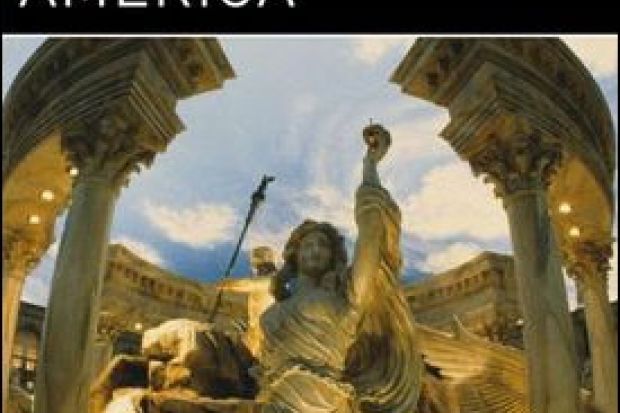According to David Grann's analysis in the New Yorker of the 2008 presidential campaign of John McCain, we understood McCain's tragic fall on 10 October 2008, when Frank Schaeffer, a lifelong Republican on the Christian Right and an active McCain supporter since 2000, criticised him in an open letter for endangering all Americans by "unleashing the monster of American hatred and prejudice ... in a country with a history of assassinations".
We learn from Margaret Malamud's Ancient Rome and Modern America, coincidentally published in the US on 10 October, that whipping up hatred against political opponents is nothing new in the history of American politics. What is relatively new is that the McCain campaign never referred to Roman history in appealing to supporters whom Schaeffer earlier addressed as "a hate-filled rabble proud of your ignorance".
Malamud covers two centuries of good old days, from the American Revolution when George Washington consciously behaved like, and was eulogised as, "a Cato and a Cincinnatus", until well along in the Cold War, throughout which American politicians, reformers, political activists, writers and artists regularly summoned the Gracchi brothers, Marius, Sulla, Cato, Julius Caesar, Cicero, Brutus, Caesar Augustus, Spartacus and Nero and used, Malamud says, "analogies and metaphors of the rise and fall of Rome as a way of commenting on and debating the state of the nation".
In her first chapter, Malamud explains how Andrew Jackson's opponents depicted him as "a Caesar, an arrogant and imperious military hero-turned-demagogue" aiming at "tyranny and damaging imperialism". Caesar, like Jackson, one critic wrote, "was the greatest democrat Rome ever produced". He was not paying his president a compliment. Jackson, too, had "cypherise(d)" the power of the Senate and would soon subject "this noble country ... to all the horrors of civil war".
In January 1835, Richard Lawrence tried to kill Jackson, the first political assassination attempt in American history. Contemporaries believed that Lawrence was motivated in part by the savage political rhetoric that portrayed "the President as a Caesar who ought to have a Brutus". Indeed, five months earlier, Senator John Calhoun had drawn parallels between Jackson and a different Caesar: "(A) government may be a republic in form, but a despotism in fact. Augustus Caesar did not change the forms of the Roman republic, but exercised a most despotic power over the laws, the liberty and the prosperity of the citizens." By citizens, Calhoun meant patricians.
But in recent memory, only Senator Robert Byrd, now a nonagenarian, regularly cited Roman history in support of his political positions. His thanks, Malamud informs us, was to be called by a fellow senator "the weirdest man in the Senate". We do not learn from her that Byrd, in opposing the Iraq War resolution and the continuing support of the war by what he called a "sheep-like" Senate, adapted his speechifying to modern tastes, eliminating allusions to figures from Roman history and adducing Jesus Christ, Hans Christian Andersen and Hermann Goering instead.
Byrd's recent rhetorical choices signal that we may now have moved beyond the ninth and final period (the 1960s through 2002) of American history that Malamud covers, an age when images of imperial Rome were used mindlessly to "promote ever-increasing consumerism and consumption". The architects of the extravagant Forum Shops mall, opened in Las Vegas in 1992, claimed to have studied the ancient version of the Eternal City for six months to capture "the elegance and opulence of true classical Rome".
It surprised Malamud that in researching the cultural reception of ancient Rome, she excavated so many different, forgotten layers of American history. But she has done us a noble service as a social historian. In her first eight periods, champions of the poor and powerless (for example, the 15 million desperately unemployed in March 1933, representing 25 per cent of the US workforce) appealed to the Gracchi brothers or Marius or Caesar in calling for reforms of intolerable disparities in wealth and power between classes they easily analogised as patricians and plebs, or even as suffering Roman slaves.
In chapter eight, Malamud wisely treats at length the novelist and activist Howard Fast. Fast grew up in the Eastern European slums of New York City and came of age during the Great Depression: "I had seen my father on strike; I had seen him locked out, his head bloodied on the picket line. I had seen the economy of my country collapse ... I knew what there was to know about the pain and filth and agony of the mean streets." A registered communist, Fast wrote his historical novel Spartacus in 1951 to symbolise "the struggles of the poor and the working people against their oppressors". In the Daily Worker, he declared: "Our battle is not the battle Cicero led, but always the battle Spartacus led."
Actor Kirk Douglas read Spartacus in 1957 and, as a child of a "dirt-poor, illiterate Jewish immigrant family" familiar with the Torah, identified straightaway with "the thousands and thousands of slaves carrying rocks, beaten, starved, crushed, dying". He said simply, "That would have been my family, me." He used his influence in Hollywood to produce and star in the film version of Spartacus (1960).
If McCain had read or seen Spartacus growing up, or had had a chance to read Malamud before he crossed his moral Rubicon, he may have remembered that to some Americans who know Roman or American history, "socialist" is not a dirty word.
Ancient Rome and Modern America
By Margaret Malamud
Wiley-Blackwell 312pp, £50.00 and £19.99
ISBN 9781405139335 and 39342
Published 10 October 2008
Register to continue
Why register?
- Registration is free and only takes a moment
- Once registered, you can read 3 articles a month
- Sign up for our newsletter
Subscribe
Or subscribe for unlimited access to:
- Unlimited access to news, views, insights & reviews
- Digital editions
- Digital access to THE’s university and college rankings analysis
Already registered or a current subscriber? Login
